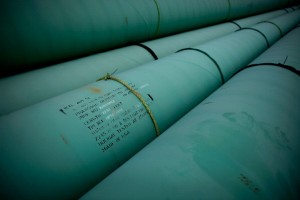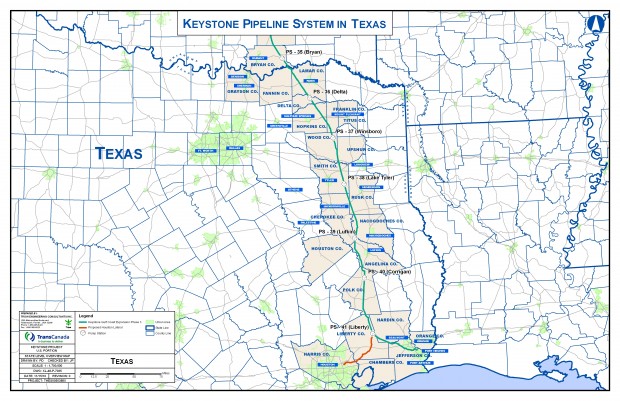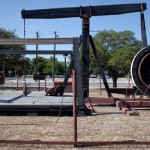TransCanada Responds to Obama’s Endorsement of Southern Leg of Keystone XL

Photo by Tom Pennington/Getty Images
Pipe is stacked at the southern site of the Keystone XL pipeline on March 22, 2012 in Cushing, Oklahoma.
Speaking in Oklahoma today, President Obama endorsed the southern leg of the Keystone XL pipeline, which would take heavy crude harvested from the oil sands of Alberta to refineries on the Gulf Coast of Texas.
And as you might expect, that’s music to TransCanada’s ears. It’s the company behind the pipeline. “We appreciate his support for the Gulf Coast project,” TransCanada representative James Prescott tells StateImpact Texas today. “Our plan is to continue our efforts to secure the permits that are necessary, so we’ve already begun that process. So we appreciate his support for expediting that.”
The entire Keystone XL pipeline was denied a permit by President Obama in January. The President cited concerns brought up by the mostly-Republican legislature in Nebraska that the pipeline crossed sensitive aquifer and prairie regions in the state and would need to be re-routed. Today he emphasized his support for starting construction on the lower leg of the pipeline while TransCanada works to find an alternate route for the proposed upper leg.
So why just build the southern half?
There is a “glut of oil” in Cushing, Oklahoma, the major oil hub where the President spoke today, according to TransCanada’s Prescott. So even without the northern leg built, the southern portion combined with the existing pipeline will carry between 500,000-700,000 barrels of heavy crude a day. (You can see the existing and proposed pipelines in the map to the right.) If and when the northern leg is added, that number will go up to 840,000 barrels per day.
Prescott says TransCanada still needs permits from the Army Corps of Engineers and other federal agencies. While these permits aren’t technically contingent on Obama’s approval, he says that “the bigger issue is that [his endorsement] certainly sends a clear message from his administration, that energy is a priority. We believe that can certainly help our efforts to secure those permits so we can start construction when we need.”
That construction on the southern leg would begin sometime this year, with service beginning sometime in mid-to-late 2013. “We still have work to do before we start construction,” Prescott says. “There’s pre-construction logistics, mobilization, and a lot of moving parts that need to be put in the right place before we can start.”
You can read more about the pipeline on our topic page on the Keystone XL pipeline. And here’s a map of where exactly the Keystone XL pipeline (in green) would go through Texas:



